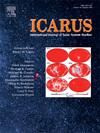Impactor core breakup during impact into a magma ocean: A parameter study
IF 2.5
2区 物理与天体物理
Q2 ASTRONOMY & ASTROPHYSICS
引用次数: 0
Abstract
The present day concentrations of highly siderophile elements in Earth’s mantle cannot be sufficiently explained by planetary differentiation processes. Material from iron cores of large differentiated bodies, incorporated into a magma ocean due to impact during the late accretion phase, may offer an explanation for the increased abundance of highly siderophile elements, which are considered a measure of the late addition of material. For the chemical equilibration of metallic impactor core material with a silicate magma ocean it is important to know whether the core breaks up. It could shatter into fragments that mix with the magma ocean or penetrates the magma ocean as a coherent mass that does not equilibrate with the surrounding silicates. In order to quantify the fragmentation process between these two end-member cases we performed hydrocode simulations of differentiated impactors into magma oceans at different impactor sizes, impact velocities and magma ocean depths. For this, we developed and implemented a new disruption method into our simulation code, which allows for a more realistic and quantitative description than previously possible. We find that there is significant breakup of the impactor core, increasing with greater magma ocean depth, until the impactor core is completely fragmented at a depth of more than twice the impactor radius. If the magma ocean is shallower, large portions of the impactor core can reach the magma ocean bottom before fragmenting, hence avoiding chemical reequilibration with the surrounding silicates.
求助全文
约1分钟内获得全文
求助全文
来源期刊

Icarus
地学天文-天文与天体物理
CiteScore
6.30
自引率
18.80%
发文量
356
审稿时长
2-4 weeks
期刊介绍:
Icarus is devoted to the publication of original contributions in the field of Solar System studies. Manuscripts reporting the results of new research - observational, experimental, or theoretical - concerning the astronomy, geology, meteorology, physics, chemistry, biology, and other scientific aspects of our Solar System or extrasolar systems are welcome. The journal generally does not publish papers devoted exclusively to the Sun, the Earth, celestial mechanics, meteoritics, or astrophysics. Icarus does not publish papers that provide "improved" versions of Bode''s law, or other numerical relations, without a sound physical basis. Icarus does not publish meeting announcements or general notices. Reviews, historical papers, and manuscripts describing spacecraft instrumentation may be considered, but only with prior approval of the editor. An entire issue of the journal is occasionally devoted to a single subject, usually arising from a conference on the same topic. The language of publication is English. American or British usage is accepted, but not a mixture of these.
 求助内容:
求助内容: 应助结果提醒方式:
应助结果提醒方式:


